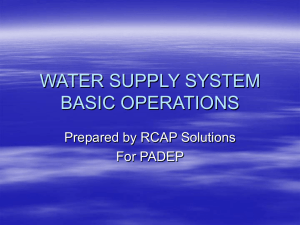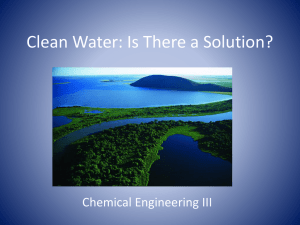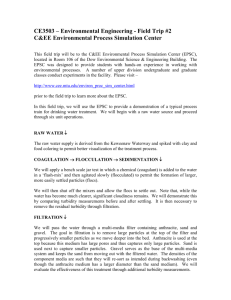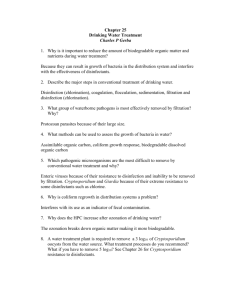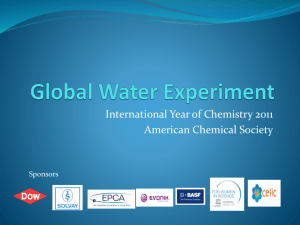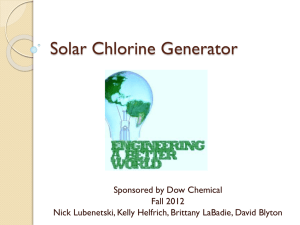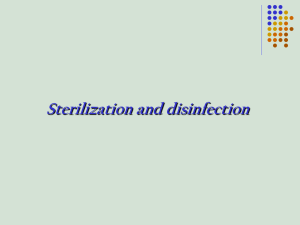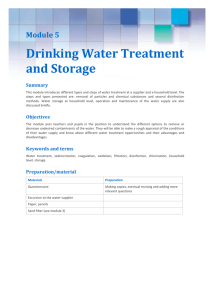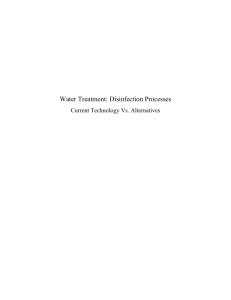Sorption and Ion Exchange: these processes deal with
advertisement
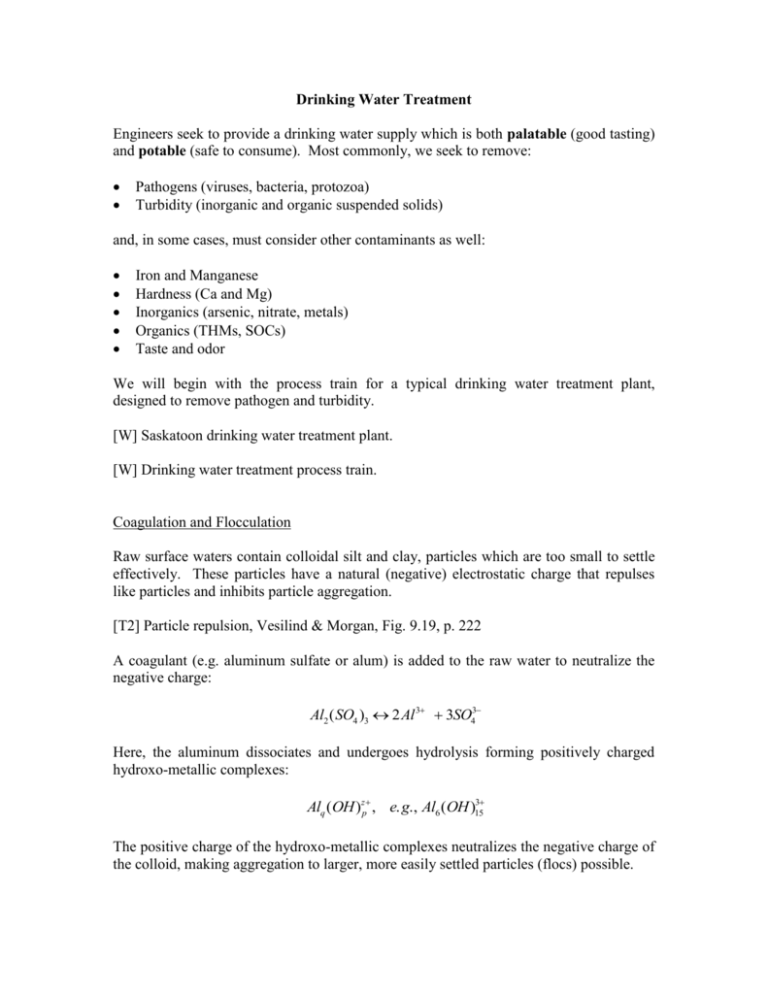
Drinking Water Treatment Engineers seek to provide a drinking water supply which is both palatable (good tasting) and potable (safe to consume). Most commonly, we seek to remove: Pathogens (viruses, bacteria, protozoa) Turbidity (inorganic and organic suspended solids) and, in some cases, must consider other contaminants as well: Iron and Manganese Hardness (Ca and Mg) Inorganics (arsenic, nitrate, metals) Organics (THMs, SOCs) Taste and odor We will begin with the process train for a typical drinking water treatment plant, designed to remove pathogen and turbidity. [W] Saskatoon drinking water treatment plant. [W] Drinking water treatment process train. Coagulation and Flocculation Raw surface waters contain colloidal silt and clay, particles which are too small to settle effectively. These particles have a natural (negative) electrostatic charge that repulses like particles and inhibits particle aggregation. [T2] Particle repulsion, Vesilind & Morgan, Fig. 9.19, p. 222 A coagulant (e.g. aluminum sulfate or alum) is added to the raw water to neutralize the negative charge: Al2 ( SO4 )3 2 Al 3 3SO43 Here, the aluminum dissociates and undergoes hydrolysis forming positively charged hydroxo-metallic complexes: 3 Alq (OH )zp , e. g., Al6 (OH )15 The positive charge of the hydroxo-metallic complexes neutralizes the negative charge of the colloid, making aggregation to larger, more easily settled particles (flocs) possible. [T2] Charge neutralization, Vesilind & Morgan, Fig. 9.19, p. 222 The hydroxo-metallic complexes also enhance floc formation by bridging negativelycharged particles. [T3] Bridging, Vesilind & Morgan, Fig. 9.20, p. 223 The coagulation process is fast and takes place in a rapid mixing device. [W] Drinking water treatment process train – Coagulation. The water is then passed to a flocculator where the coagulant and colloids are gently agitated to promote particle contact and the formation of larger particles. [W] Drinking water treatment process train – Flocculation. Note that the speed of the mixing paddles is reduced as particles grow in size to avoid breaking up the aggregates. Sedimentation Once the particles are formed, the next step is to remove them by sedimentation (settling). The gravity settling tanks used are designed to minimize turbulence and reduce short-circuiting. [W] Drinking water treatment process train – Sedimentation. A particle will be trapped if it settles to the bottom of the tank before it exits, i.e. if, h v remember that V Q Thus the efficiency of particle removal varies with the particle settling velocity (v), as determined by Stokes’ Law: v d 2 g p f 18 [T4] Particle settling velocities, Vesilind & Morgan, p. 226 It can be seen from Stokes’ Law and the table below that some small, low density particles would have a very slow settling velocity and require a very long time and thus a very large tank in order to be removed from the water. The sludge generated through sedimentation is composed of largely inorganic materials which are wasted into a sewer or sludge dying pond. Filtration Small inorganic particles, protozoa and some (but not all) bacteria are removed through filtration. Two types of filters are employed: Slow sand filters have a single (sand) medium and do not require sedimentation as a preliminary step. The filters go through a ripening phase at startup where a zoogleal growth (schmutzedecke) establishes itself in the upper layers of the filter. This layer achieves most of the filtration. After a period of time, head loss increases to the point where the filter must be cleaned. A layer of sand is removed by mechanical scraping, leaving a portion of the zoogleal growth so that filter performance is not impaired. Slow sand filters have low loading rates. Rapid sand filters utilize a multimedia (contain a combination of anthracite, garnet, sand and, sometimes, activated carbon) approach and require sedimentation or addition of a coagulant aid as a preliminary step. Rapid filters have high loading rates. When head loss occurs, the filters are cleaned by backwashing, i.e. reversing the flow and flushing at a rate high enough to expand the bed. Because of density differences, the media naturally sort after backwashing. Filters must be cleaned every 1-4 days depending on influent water quality. [W] Drinking water treatment process train – Filtration Disinfection This last treatment applied to water is intended to remove or inactivate disease-causing microorganisms. Chlorine or its derivatives (chlorine dioxide) are the least costly and most commonly used disinfectants. The addition of chlorine to water yields hypochlorous acid and hypochlorite ion: Cl2( g ) H 2O HOCl H Cl HOCl OCl H Hypochlorous acid is 80-200 times more effective as a disinfectant than hypochlorite ion and thus pH must be taken into account in determining disinfection efficiency. [T5] pH and chlorine distribution Current disinfection standards, established under the Surface Water Treatment Rule (SWTR) are based on a 99.9% inactivation (3 log reduction) of Giardia cysts and a 99.99% inactivation (4 log reduction) of enteric viruses. These organisms were chosen as standards because of their resistance to disinfection (thus bacteria are removed as well). [W] Drinking water treatment process train – Disinfection Disinfection is accomplished in a contact tank, with operation based on the CT concept, i.e. the product of disinfectant concentration (C, mg·L-1) and contact time (T, min) must be maintained. Tables of CT values (e.g. min·mg·L-1) are published for specific combinations of pathogens and disinfectants and which account for the effects of temperature and pH on disinfection efficiency, e.g. CT 0.9847C 0.1758 pH 2.7159 temp 0.1467 Chlorine oxidizes the organic matter (including microorganisms) present in the water. The presence of residual chlorine in the water indicates that no further organics remain to be oxidized and the water can be assumed to be free of pathogens. It is important to maintain a chlorine residual on into the disinfection system to guard against subsequent contamination. Addition of chlorine to waters containing natural organic matter (NOM) can lead to the generation of disinfection by-products (DBPs, THMs) which may endanger public health. For this reason, chlorine dioxide (which does not react with organics, thus no DBP), UV light and ozone are becoming more widely used, as they produce no DBPs. However, these treatments do not yield the residual disinfecting power required to protect the distribution system. In these cases, chloramines can be used to maintain a chlorine residual. Chloramines are formed through reactions between chlorine and ammonia naturally present or added to the water. Three types of (mono-, di-, tri-) chloramines are formed: NH3 HOCl NH2Cl H2O NH3 2 HOCl NHCl2 2 H2O NH3 3HOCl NCl3 3H2O The distribution of the three forms depends on pH. Dichloramine produces a disagreeable taste and odor where monochloramine does not. Trichloramine is not stable and breaks down rapidly. The disinfecting power of chloramines is less than that of chlorine but they are much longer lasting in water and thus provide a degree of residual protection. This process train, composed of four unit operations (coagulation/flocculation, settling, filtration and disinfection) is representative of a typical water treatment facility. [T6] Drinking water treatment process train Where other substances are present which may render the water unpalatable and/or nonpotable, additional treatment processes must be instituted. But first, let’s look at some principles of equilibrium chemistry which are fundamental to many of the unit operations in water treat (applying also to wastewater treatment). [T7] Equilibrium chemistry Go To Equilibrium Chemistry Notes Aeration or Pre-Oxidation Ferrous iron (Fe2+) and manganous manganese (Mn2+) are soluble (invisible) forms that may exist in groundwater or anaerobic reservoir waters. When exposed to air, they form insoluble, visible, oxidized ferric iron (Fe3+) and manganic manganese (Mn4+). If not removed in treatment, the brown-colored oxides of iron and manganese create aesthetically unpleasing conditions and may interfere with some water uses. [T8] Iron and manganese in drinking water Iron can be removed through simple aeration; manganese removal requires that the pH of the water be raised prior to aeration. Alternatively, chemical oxidants such as chlorine or permanganate, can be added at the head of the plant to oxidize Fe and Mn to insoluble forms. The precipitates formed through oxidation are then removed by settling and filtration. Softening Hardness is caused by the presence of multivalent cations (minerals, e.g. calcium, magnesium and iron) in both surface and groundwaters. The term ‘hardness’ evolved as a colloquial reference to the difficulty of laundering in waters with high concentrations of mineral ions. Hardness reacts with soap to form scum (bathtub rings) and can precipitate a scale from heated water reducing the heating efficiency and life of appliances and pipes which work with water. [T9] Hardness Water is softened (i.e. hardness is removed) by the lime-soda process or by ion exchange. Lime-soda softening Here, lime (Ca(OH)2) and soda (Na2CO3) are added to precipitate the calcium ions as CaCO3 and the magnesium ions as Mg(OH)2: Ca 2 CO32 CaCO3 Mg 2 2OH Mg (OH ) 2 K sp ,CaCO3 Ca 2 CO32 K sp , Mg ( OH )2 Mg 2 OH 2 At the pH of most source waters, the carbonate ion required for precipitation of calcium carbonate is present as bicarbonate: CO2 H2O H2CO3 HCO3 H CO32 H Increasing the pH of the water favors the precipitation of Mg(OH)2 (more hydroxyl ions) and converts bicarbonate to carbonate, favoring the precipitation of CaCO3. Lime is the least expensive and most easily handled chemical for accomplishing this: Ca( OH )2,s Ca 2 OH 2 When bicarbonate concentrations are insufficient to remove all of the calcium, soda ash may be added to raise the pH and provide additional carbonate ions: Na2CO3,s Na 2 CO32 The calcium and magnesium precipitates so formed are removed in the sedimentation or filtration units. Ion exchange softening A polystyrene (plastic) resin manufactured in the form of small (0.5 mm) spheres. The resin has an anionic component which absorbs cations (e.g. calcium and magnesium). Ca 2 Na2 R CaR 2 Na Mg 2 Na2 R MgR 2 Na When the calcium and magnesium ions occupy most of the sites, the efficiency of ion exchange is reduced and the resin is said to be exhausted. The resin is then regenerated by adding excess sodium ion, in excess CaR NaCl Na2 R Ca 2 The solution containing the regenerated Ca2+ and Mg2+ ions is wasted to the sewer. Adsorption with Activated carbon Synthetic organic chemicals (SOCs) include a large number of manufactured chemicals used in industry, agriculture and household applications. Many are potentially toxic. In addition, a variety of organic chemicals found in nature impart taste and odors to water. Finally, the chlorination process yields disinfection by-products (DBPs) such as trihalomethanes (THMs) which pose health hazards. Adsorption with powdered (PAC) or granular (GAC) activated carbon is usually the most effective way of removing these chemicals. [T10] Granular activated carbon Dissolved, colloidal, and particulate substances are attracted and attach to the surface of carbon particles. [T11] The adsorption process [T12] Tendency to sorb The carbon may be used in batch or continuous flow operations and is sometimes one of the media used in filtration units. [T13] Application in water treatment When the adsorption capacity of the carbon is eventually exhausted, it is regenerated by heating which burns and volatilizes the compounds. [T14] Column operation Adsorption with Iron Arsenic and various metals can be removed by adsorption with iron, where iron salts replace alum in the coagulation step. [T15] Asbestos and trace metal removal Membrane Processes Various types of membrane processes may be used either as stand-alone treatment or in conjunction with traditional processes to remove contaminants. [W] Membrane processes On-Site Water Treatment [T16] On-site water treatment
